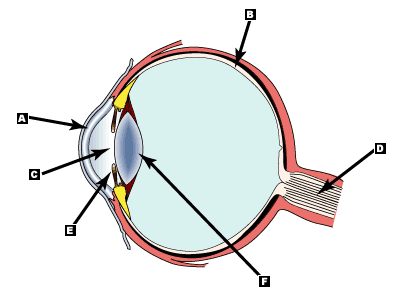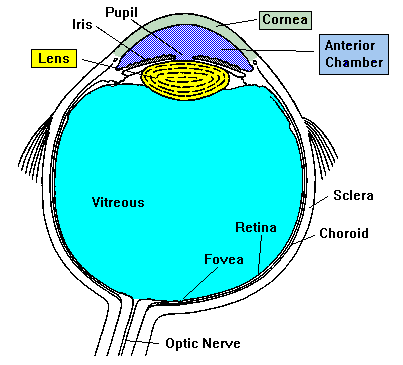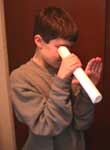Розробка бінарного уроку ( англійська та біологія ) з теми " Око "
Water glasses: Have a set of glasses with differing amounts of water in them.
T 1: Good morning! Nice to see you
Look at the table. What can you see there?
Ss :Some glasses of water
T1: Close your eyes and listen carefully.
T taps the glasses with a pencil
T1: . Do the glasses sound the same or different?
Ss : They sound different because they have different amount of water
T1: How do you know that they are glasses with water? What helps you to understand it?
How do you know that they sound different? What do you use to define it?
Ss: Our eyes help us understand that the glasses are with water and our ears let us define that the sound is different
T2: You’re right.. We use our senses every day to identify sights, sounds, smells, tastes. They help us to enjoy our food, the sound of music, the beauty of a sunny day and so on.
The senses appear on the screen
T2 : Today we are going to talk about one of the senses and it is the sight .We’ll review the structure of the human eye, work into teams and do some experiments.
T puts the tasks on the board
You’ll need some terms for our lesson such as -
|
- cochlea
Pair Work T1: Complete the table with the words matching the terms to their definitions
|
Key
|
|
Sensors, located beneath the skin, that send nerve messages to the "touch" center of the brain. |
|
|
|
Shaped like a snail's shell, this part of the ear receives vibrations. |
|
|
|
The opening in the front of the eye that lets in light. |
|
|
|
The nerve, located at the top of the inner nose, that sends odors to the brain. |
|
|
The thin lining of cells, located in the back of the eye, that translates light patterns into nerve signals, which are sent to the brain. |
T2 : Look at the screen and check your answers
T2: Do you know that the human eye is about 2.5 cm in length and weighs about 7 grams. Humans are very visual animals...we use our sense of sight to interpret much of the world around us. Do you remember how the human eyes work?
T1: We are going to watch the video about the work of an eye. Be very attentive such as then you’ll have to write the parts of the eye.
Video “ How Human Eyes Work “
Group of 4
T2 : We’re going to work into groups of 4 so let’s make the groups.
Using the words, and the table with the definitions, write the part of the eye. Your time limit is 3 minutes

Ss get the sheet with the eye
T1 : Time’s up. _________ show us your picture and read out the words

T1 :And now the most interesting part of our lesson. We will do some experiments to find out some more information how our eyes work. We go on working into groups. Each group will make its own experiment having 2 minutes only for the task. Then you will change your sits and make the next one and so on.
I. ![]() The Blind Spot
The Blind Spot
One of the most dramatic experiments to perform is the demonstration of the blind spot. The blind spot is the area on the retina without receptors that respond to light. Therefore an image that falls on this region will NOT be seen. It is in this region that the optic nerve exits the eye on its way to the brain.
This next image allows you to see another way your brain fills in the blind spot. Again, close your right eye. With your left eye, look at the +. Slowly move your head closer to the image. The space in the middle of the vertical lines will disappear.

II. ![]() Shifting Backgrounds, Shifting Images
Shifting Backgrounds, Shifting Images
Here's another way to demonstrate how different images are projected on to each eye. Look at an object in the distance (20-30 feet away), such as a clock on the wall. Close one eye, hold up your arm and line up your finger with the object. Now without moving your finger or your head, close the opened eye and open the closed eye. The object in the distance will appear to jump to the side...your finger will no longer be lined up. This shows that different images fall on each eye.
III. ![]() X-Ray Vision??
X-Ray Vision??

 Do you have "X-Ray Vision?" You may be able to see through your own hand with this simple illusion. Roll up a piece of notebook paper into a tube. The diameter of the tube should be about 0.5 inch. Hold up your left hand in front of you. Hold the tube right next to the bottom of your left "pointer" finger in between you thumb (see figure below).
Do you have "X-Ray Vision?" You may be able to see through your own hand with this simple illusion. Roll up a piece of notebook paper into a tube. The diameter of the tube should be about 0.5 inch. Hold up your left hand in front of you. Hold the tube right next to the bottom of your left "pointer" finger in between you thumb (see figure below).
Look through the tube with your RIGHT eye AND keep your left eye open too. What you should see is a hole in your left hand!! Why? Because your brain is getting two different images...one of the hole in the paper and one of your left hand.
T2 : Which of the experiments did you like most f all?
T1 : Sometimes the eyes play tricks with us which are usually called optical illusions. Pay your attention to the screen. There is some more information for you. Watch the video and complete the table
Video 10 Mind Blowing Optical Illusions
|
|
This illusion is created with distorted perspective of an image that requires to be viewed at a specific vantage point to create the 3-D effect |
|
|
This illusion creates cartoonish effect of drastic size differences between people and objects |
|
|
The dress can be seen as either black and blue or white and gold |
|
|
It’s easy to assume that the dots are moving while they aren’t |
|
|
It seems the images are moving due to cognitive effects of interacting colour contrasts and shape positioning |
|
|
It creates a multiple frame animation on a single sheet of paper by manipulating the mind and eyes |
Key
|
Flat 3-rd dimension |
This illusion is created with distorted perspective of an image that requires to be viewed at a specific vantage point to create the 3-D effect |
|
The Ames room |
This illusion creates cartoonish effect of drastic size differences between people and objects |
|
The dress |
The dress can be seen as either black and blue or white and gold |
|
Circle illusion |
It’s easy to assume that the dots are moving while they aren’t |
|
Motion illusion |
It seems the images are moving due to cognitive effects of interacting colour contrasts and shape positioning |
|
Animation illusion |
It creates a multiple frame animation on a single sheet of paper by manipulating the mind and eyes |
Summarising
T1: gets back to the tasks and says : Today we reviewed the structure of the human eye, worked into teams and did some experiments
Have you found something new today?
What was interesting for you?
What was difficult?
Homework
To describe one of the optical illusions with the explanation how it works


про публікацію авторської розробки
Додати розробку
